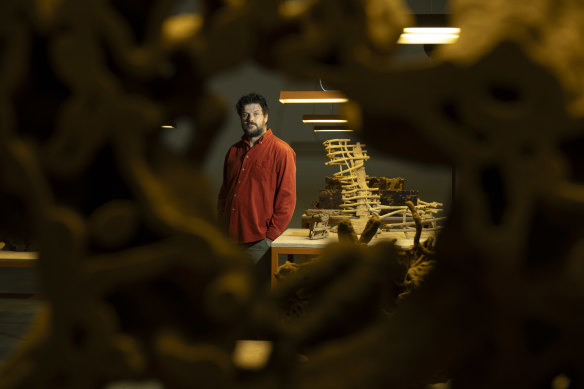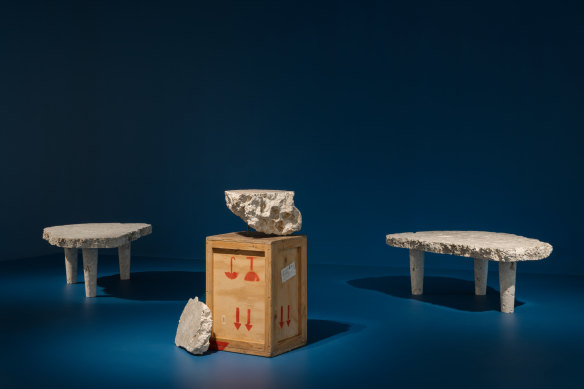
Few artists are as well-informed in diverse fields of knowledge as Nicholas Mangan. In Mangan’s survey exhibition at the Museum of Contemporary Art, A World Undone, one can’t help but be impressed by the breadth of his interests and the thoroughness with which he pursues them.

Nicholas Mangan: a superabundance of content.Credit: Janie Barrett
In the first essay in the catalogue, Amelia Barakin provides a summary that could hardly be improved upon: “All his projects involve the aggregation of different media – be it film, sculpture, photography, archival documentation, installation or sound – that crystallise around networked concepts (ecology, capitalism, colonisation, climate change), which then cross-disciplinary borders (art, neuroscience, geology, zoology, economics, politics).”
At this point, you’ll either be hooked or thinking, “Ooooh no.” After looking at Mangan’s exhibition and reading the catalogue, I’m somewhere in between. There’s formidable intelligence in this body of work and a remarkable ability to make connections between apparently disparate subjects. Yet, this doesn’t translate into outstanding art. Despite a superabundance of content, there’s no lure that catches the eye and makes one want to linger for more than the time it takes to register each component of a room-sized installation. There’s recognition but not seduction.
The first project one encounters is called Nauru – Notes from a Cretaceous World (2009-10). The Cretaceous period came to an end roughly 66 million years ago, but the key date for the island of Nauru was 1900, which saw the discovery of vast reserves of phosphate. When ownership of the mines passed into the hands of the islanders in 1970, it put them among the richest nations on earth. They celebrated in 1977 by building Nauru House, a 52-storey skyscraper in Melbourne’s CBD.
In the early 2000s the phosphate and the money ran out, obliging Nauru to sell the trophy building, completing a rags-to-riches-to-rags fairytale. Mangan has picked up the story on the way down, fulfilling an idea of an earlier Nauruan president, that lumps of coral limestone brought to Australia might be turned into coffee tables and sold for income. In this show, that dream is realised with a very rudimentary coffee table made from jagged, pale stone. It’s accompanied by photos, crates, documents and other bric-a-brac that give us a scattered impression of a tropical island, its ecology ruined by strip mining, that has been chewed up and spat out by the colonialist-capitalist machine.

A president’s dream realised: Nicholas Mangan’s Proposition for Dowiyogo’s Ancient Coral Coffee Table, 2009.Credit: Hamish McIntosh
Later in the show, Mangan revisits this theme in a project called Progress in Action (2015), looking at the island of Bougainville, where the ravages of copper mining drove the inhabitants to take up arms and fight for independence from Papua New Guinea. After their opponents cut off the supply of fuel, the Bougainvilleans fell back on making biofuel from coconuts. Mangan copied them, marvelling at how many coconuts were required for a litre.
The MCA installation includes a generator that would run on this fuel, and a lot of empty coconut shells. The centrepiece is a film loop of the conflict spliced together from footage found in the National Archives of Australia. Mangan talks about historical events informing the “sculptural gestures” he deploys, in a process he calls “material storytelling”.
This reflects an expanded conception of sculpture that may include film, archival footage and documents, or even the geographical-geological reality of a particular location. It’s a complex procedure that tends to pack too much information into every work with no clear narrative. When viewers have figured out the connections, rather than shouting “Eureka!” they’re more likely to say: “So what?”









 Add Category
Add Category